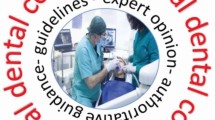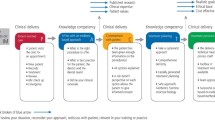Key Points
-
This paper illustrates how the BNF can facilitate rational prescribing.
-
It explains how to select effective drug treatments, minimise harm in patients with co-morbidities and minimise drug interactions and adverse drug reactions.
-
It explains how to select drug treatment in special patient groups.
-
It explains how to choose the right dose.
-
It provides advice on when it is appropriate to prescribe an unlicensed medicine.
Abstract
The BNF can be used as a tool to facilitate rational prescribing. In the second of this two-part series, we describe how dentists can maximise the effectiveness of their prescribing and minimise the risks involved while tailoring medicines to the individual needs of each patient.
Similar content being viewed by others
Using the BNF as a tool for rational prescribing
The rational use of medicines involves striking the balance between:
-
Maximising effectiveness
-
Minimising risk
-
Respecting patient choice, and
-
Minimising cost.1
In this second article of a two-part series we describe how the British National Formulary (BNF)2 can be used as a tool to achieve rational prescribing.
Identifying effective drug treatments
The prescribing notes in the BNF provide an overview of the drug management of common oral conditions and allow you to appraise treatment options rapidly. For example, Table 1 in chapter 5 provides advice on the initial antibacterial treatment of various oral infections (Fig. 1). However, to select safe and effective drug treatments in individual patients, you need to use this type of information in conjunction with prescribing details of the drugs and a knowledge of the patient's medical and drug history.
Minimising drug hypersensitivity reactions
Prescribing a drug for which an allergy already exists is recognised as a cause of fatal prescribing error.3 You should ask if the patient has any drug allergies and record them carefully (see Example 1).
Minimising harm in patients with co-morbidities
The drug you choose to treat an oral condition should have minimal detrimental effects on the patient's other diseases and minimise the patient's susceptibility to adverse effects. To achieve this, you need to review the cautions and contra-indications of the drug you intend to prescribe. This information can usually be found in the drug monograph. However, if a class of drugs, such as the tetracyclines, share the same cautions and contra-indications, these are amalgamated in the prescribing notes, while those unique to a particular tetracycline are included in its individual monograph (Fig. 2).
Examples 2 and 3 illustrate how the drug treatment of severe periodontitis varies according to the patient's co-morbidities. The information under Cautions allows you to assess the risks of using a drug in a patient with co-morbidities that are also included in the Cautions for that drug – if a safer alternative cannot be found, the drug may be prescribed while monitoring the patient for adverse effects or deterioration in the co-morbidity. Contra-indications are far more restrictive than Cautions and mean that the drug should be avoided in a patient with a contra-indicated condition. For example, non-steroidal anti-inflammatory drugs (NSAIDs) should be avoided in patients with severe heart failure.
Minimising harm in patients with hepatic or renal impairment
Hepatic or renal disease may alter the metabolism or excretion of some drugs. Hepatic reserve and renal clearance reduce with age, and the elderly are particularly susceptible to the side-effects of drugs that are eliminated by these routes. Appendices 2 and 3 in the BNF provide guidance on drugs to be avoided or used with caution in hepatic or renal impairment (see Examples 4, 5, 6). You should aim to:
-
Select drug treatments that minimise the potential for drug accumulation, adverse drug reactions and exacerbation of pre-existing liver or renal disease
-
Make appropriate drug dose adjustments for these patients
-
Monitor patients appropriately if it is necessary to prescribe drugs whose response is altered by liver or renal disease.
In the Appendices of the print version of the BNF, drugs are included in alphabetical order. In the digital versions, this information can be accessed directly from hyperlinks located in the drug monographs.
Minimising harm during pregnancy and breast-feeding
Appendices 4 and 5 in the BNF provide guidance on drugs to be avoided or used with caution during pregnancy or breast-feeding (see Examples 7 and 8). You should aim to:
-
Determine whether a mother's condition requires drug therapy
-
Select drug treatments that minimise harm to the foetus, nursing infant and mother
-
Monitor the infant for potential side-effects of drugs used by the mother during pregnancy or breast-feeding.
Minimising drug interactions
Details of drug interactions can be found in Appendix 1 of the print version of the BNF. Drugs are listed in alphabetical order. The symbol • is placed against interactions that are potentially hazardous and where combined administration of the drugs should be avoided (or only undertaken with caution and appropriate monitoring) (Fig. 3). Interactions that have no symbol do not usually have serious consequences.
In the digital versions, you can search for interactions between a combination of drugs using the Interactions search facility (Fig. 4). Alternatively, interactions for a specific drug can be accessed from a hyperlink in the drug monograph. Potentially hazardous drug interactions are shown in bold on a pink background while those without serious consequences are shown on a beige background.
Examples 9 and 10 show how use of the BNF can help prescribing in cases with potential for drug interaction.
Side-effects
The BNF includes clinically relevant side-effects for most drugs. Recognising that hypersensitivity reactions can occur with virtually all medicines, this effect is not generally listed, unless the drug carries an increased risk of such reactions. The BNF also omits effects that are likely to have little clinical consequence (eg transient increases in liver enzymes).
Side-effects are generally listed in order of frequency and arranged broadly by body systems. Occasionally rare side-effects might be listed first if it is considered to be important because of its seriousness.
When choosing a drug you should review the impact that any potential side-effect may have on a patient's quality of life. In other words, you need to assess the risks and benefits of prescribing a particular drug (see Example 11).
Selecting the right dose and route
The dose is located in the Dose section of the monograph or preparation entry in the BNF. The doses of some drugs vary according to indications – if no specific dose is given for a dental indication then the general dose can be used. The dose for children will vary according to their age or body-weight. You may need to adjust the dose of some drugs if their effects are altered by concomitant use with other drugs, or in patients with hepatic or renal impairment. Where a drug can be administered by more than one route you should ensure that you choose the right dose for the right route (see Example 12).
Minimising antibiotic resistance
To minimise the development of resistant organisms you should:
-
Select an antibiotic with a spectrum of activity that is appropriate for the infection. Regional guidelines and local patterns of resistance will influence your treatment
-
Use adequate doses of an antibiotic
-
Avoid unduly prolonged courses of antibiotics.
Finding a suitable formulation
You should prescribe a formulation that is suitable for your patient and that fits in with their daily routine. Use sugar-free preparations where possible.
Involving the patient
The whole prescribing process will be a waste of time if your patient does not take the medicine you have prescribed. You should agree the health outcomes and the strategy for achieving them with your patient. You should also take the time to explain the rationale and the potential adverse effects of treatment.
Writing legible prescriptions
The section on 'Prescription Writing' is located near the front of the BNF under 'General Guidance on Prescribing'. It provides useful tips on writing clear prescriptions that will minimise dispensing and administration errors.
Monitoring drug treatment
You need to ensure that the treatment you prescribe is achieving the expected benefits, while monitoring the patient for unwanted side-effects. Patients are often the first to notice some of these changes and, if possible, you should involve them in the monitoring process.
Reporting adverse drug reactions
All adverse drug reactions (ADRs) to newly licensed medicines and serious adverse drug reactions to established medicines should be reported to the MHRA on the yellow cards supplied with the print version of the BNF, or online at http://www.yellowcard.gov.uk. (see Example 13).
Unlicensed medicines
The BNF includes unlicensed use of medicines when the clinical need cannot be met by licensed medicines; such use should be supported by appropriate evidence and experience. For example, the BNF recommends the unlicensed use of buccal midazolam for the emergency treatment of status epilepticus in dental practice. The alternative licensed drugs are not practical for dentists to administer by intravenous injection or by the rectal route.
Final remarks
We encourage you to become familiar with the information on drugs that you prescribe and encounter frequently, and to apply the principles of rational prescribing when choosing drug treatment. In this way the complexity of the prescribing process can be eased.
References
Barber N . What constitutes good prescribing? BMJ 1995; 310: 923–925
Joint Formulary Committee. British National Formulary. 55th ed. London: British Medical Association and Royal Pharmaceutical Society of Great Britain, 2008.
Patient Safety Observatory. Safety in doses: medication safety incidents in the NHS. London: National Patient Safety Agency, 2007.
Acknowledgements
We thank L. Oliver, P. Wilder and P. Lee for preparing images of the BNF.
Author information
Authors and Affiliations
Corresponding author
Additional information
Refereed paper
Rights and permissions
About this article
Cite this article
Wray, D., Wagle, S. A dentist's guide to using the BNF: part II. Br Dent J 204, 487–491 (2008). https://doi.org/10.1038/sj.bdj.2008.347
Published:
Issue Date:
DOI: https://doi.org/10.1038/sj.bdj.2008.347







